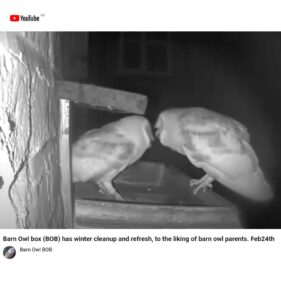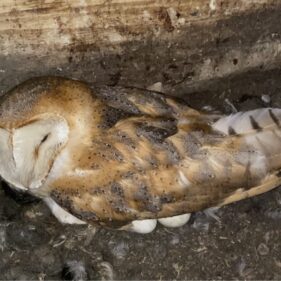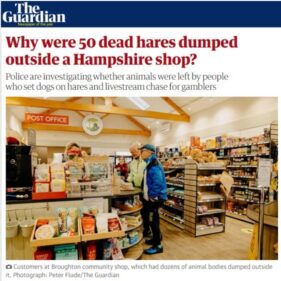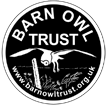News Bytes – March 2024
These news bytes have appeared on our social media sites, Facebook, X, formerly known as Twitter and Instagram during the month and have been pulled together here.
Thank you so much to A-Tec Design for all your hard work and generosity – we’re delighted to be in our new warm!! and environmentally friendly offices! Click here to see the full story of our office rebuild.

Barn Owl BOB’s Barn Owls are active at their nestbox already this year!
Have a look at @ barnowlbob on YouTube to follow the story of Barn Owls visiting a nest site in East Yorkshire and having owlets in June 2023. Watch the events unfold as the owlets hatch, grow up and take their first flights. Here is a link to Barn Owls in spring.

The area in which a Barn Owl lives is called its ‘home range’. We don’t use the word ‘territory’ because, unlike some other bird species, such as Tawny Owls, Barn Owls don’t try to defend the area from others of their own species. A home range is very simply the area that they use for hunting, roosting and breeding. The home range occupied by one Barn Owl not only overlaps with that of its mate but also overlaps with the home ranges of other individuals and pairs (except where the birds are very scarce). Here’s some information on the Barn Owls home range.

Shakinah came all the way from Malaysia to complete a 2-week internship at the Trust in 2019, and now she is studying for a PhD! Her research is on Southeast Asian Barn Owls (Tyto javanica javanica) and investigates how increasing local Barn Owl populations can be an alternative to rodenticide use in oil palm plantations. They hope to increase education and awareness regarding the wider impacts of pesticide use, as well as identify specific pesticides that bioaccumulate in the environment.

Mateo helped with some Tawny Owl nestbox checks last week and was surprised to find an early nester already sitting! Can you spot her? We are now entering the main egg-laying period for Tawny Owls, and they will nest in a variety of places. They prefer tree cavities where available, but will take readily to purpose-built nestboxes.
Discover all about Tawny Owls here.

Yesterday we had the first Barn Owl egg of the year reported
When on a field visit fixing a camera at one of our annual monitoring sites, Assistant Conservation Officer Tim was rewarded with a view of a Barn Owl pair in the nestbox and at least one egg when the footage came back on.
Prior to 1990, in the UK, the average date for the first egg was May 9th. Since then, it has moved forward to April 17th. This egg is therefore very early and fingers crossed we don’t experience any extreme weather that may jeopardise the success of this pair
Has anyone else had any sightings of early eggs on a nestbox camera yet?
If you have any sightings of Barn Owls or have found evidence of roosts or nests, then we would be very grateful if you could upload your records to our online survey. The data is invaluable and contributes to research, monitoring and reporting conducted by the Trust. This data is not shared publicly, including the exact location of the site.

10 ways to encourage wild Barn Owls.
– Manage land for Barn Owls
– Provide a roosting and nesting place
– Avoid using Rat Poison (rodenticides)
– Offer extra food in bad weather
– Buy from wildlife-friendly farmers
– Help your local Barn Owl Group
– Start your own Barn Owl Project
– Object to damaging rural developments
– Help minimise climate change
– Support the Barn Owl Trust

Calling all Devon landowners interested in creating ideal Barn Owl foraging habitat
Would you like a site visit from us to discuss how to incorporate and manage rough grassland on your land?
Rough grassland is optimum Barn Owl foraging habitat because it provides year-round prey availability – crucial to Barn Owls throughout those long winter months! Therefore, including rough grassland in field margins, inaccessible sections of field (perhaps too steep to cut), in alternating strips of hay meadows, or as part of a grazing rotation, are just some of the ways it can be incorporated.
As a successional habitat, rough grassland does need to be lightly managed, either through light grazing or topping. We can chat through grazing densities and cutting regimes to suit your land, along with various agri-environmental scheme options, on our visit. We also have a webpage on rough grassland management here.
We are hoping to provide site visits between March – May and so, if keen for a visit, please email info@barnowltrust.org.uk or give us a ring on 01364 255256.

Would you like to help raise money for the Barn Owl Trust? The Movement for Good Awards gives over £1 million a year to charities and you can help by nominating us to receive a grant of £1000! Nominating us is easy – simply click on the link here and complete the very brief form, and we will be put into a monthly draw to receive £1000. You can only do one nomination per person, but please feel free to share the link with family and friends. The more nominations we get, the better chance of winning!
Thank you for your support

Learn how to create and manage ‘rough grassland’ and what exactly it is, and discover why a litter layer is so important!
Rough grassland is also fantastic for insects and insectivorous birds, and the wild flowers of rough grassland, the grasses, and the butterflies they support are beautiful Click on this link for further information.

Barn Owl feathers are very soft, which is an adaption for quiet flight.
The flight feathers are covered in a thin hair-like structure that traps air within the feather surface. This helps to maintain a smooth air-flow across the wings and thereby avoid stalling at very low airspeeds.
The foremost wing feather (the 10th primary) also has a row of tiny hooks that help to deaden the sound of air hitting the wings’ leading edge.
Almost-silent flight enables the birds to hear the tiny sounds produced by their small mammal prey and approach them undetected.
Compared with other birds, Barn Owl feathers are not particularly waterproof.
They generally avoid hunting in rain as wet feathers increase noise and reduce efficiency.

Wonderful to see – it never gets old!
Watch more Barn Owl webcams from around the world!
Spring is here and so is the Spring edition of Feedback!
A big thank you to Chris Gee for the stunning cover photo for this issue!
For all those who receive it by post, it was collected on Monday and should be with you in time for some Bank Holiday reading For all our supporters who receive this publication in full colour by email…check your inboxes now!!
If you would like to hear more about the work of the Trust, support our conservation work and receive our Feedback magazine twice a year, then please consider becoming a Friend of the Trust or Adopting a Barn Owl – For more info go to this link.
Thank you for all your support!

A recent search of our records revealed 42 cases of Barn Owl collisions with overhead cables. These collisions largely resulted in injury or death of the bird either from electrocution or the physical impact with the wire. The risk of electrocution can be reduced by insulating cables and we urge that anyone who finds an electrocuted bird take a photo and contact their local Electricity Distribution Company to ask for the wires/droppers to be insulated. More information on this hazard here.

As natural cavity nesters, Barn Owls are attracted to dark entrance holes. This is why we always advise that nestboxes be positioned so that their entrance hole faces out over open countryside, making it as visible as possible to a passing Barn Owl. Their penchant for dark entrance holes was perfectly illustrated when this Barn Owl was released in someone’s garden, only for the owl to fly straight back into their house and seek out the nearest dark cavity it could find…. their washing machine!
Note, the Barn Owl in question was subsequently safely removed and released!
Click here to find out more about where to site a nestbox.

Mateo recently spotted an adult female Wheatear on the reserve
This migratory species winters in central Africa and this one was probably on its way back to breed on Dartmoor. It’s only the 8th record ever for us!
Check out our wildlife diary to find out more about what species visit the LLP.

We were shocked and saddened to hear about the barbaric treatment of animals, including a Barn Owl, in this article in The Guardian.
You can report wildlife crimes to the National Wildlife Crime Unit here.
“Alongside the pain and suffering experienced by animals, wildlife crime can also significantly impact conservation status by pushing species closer to extinction.” – The Rural and Wildlife Crime Strategy 2022-2025
Barn Owls are included in Schedule 1 of the Wildlife & Countryside Act 1981 which affords them protection against disturbance whilst nesting, in addition to the basic level of protection afforded to most wild birds. Find out more here.

It’s a hard life being a goat in conservation!
Alfred, Archie and Annie were thoroughly enjoying the sunshine whilst watching a very kind volunteer carrying out the ploughing for us last week. The area is now ready for our Reserve Officer to power harrow and sow the winter bird seed. Thank you so much Peter! Find out more about our reserve here.

Do you hear Tawny Owls calling at night?
Tawny Owls are responsible for the most commonly heard owl sound, the classic, nocturnal ‘twit twoo’ call, with which most people are familiar
The home range is typically established in the late autumn, and defended throughout the winter until the spring when breeding commences. Vocalisations are common throughout this period, most often at night, although some calling can occasionally be heard in broad daylight. For more Tawny Owl information click on this link.

